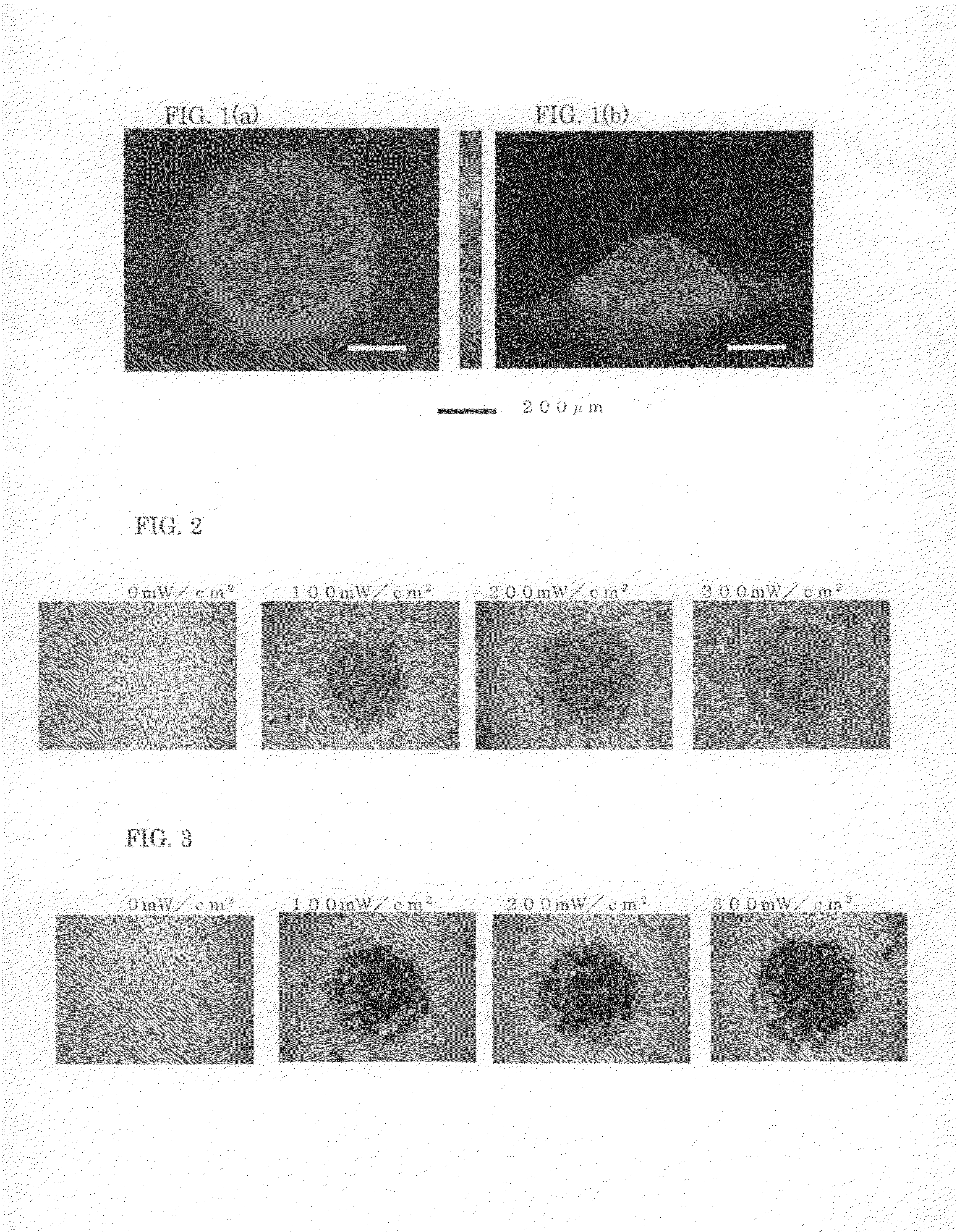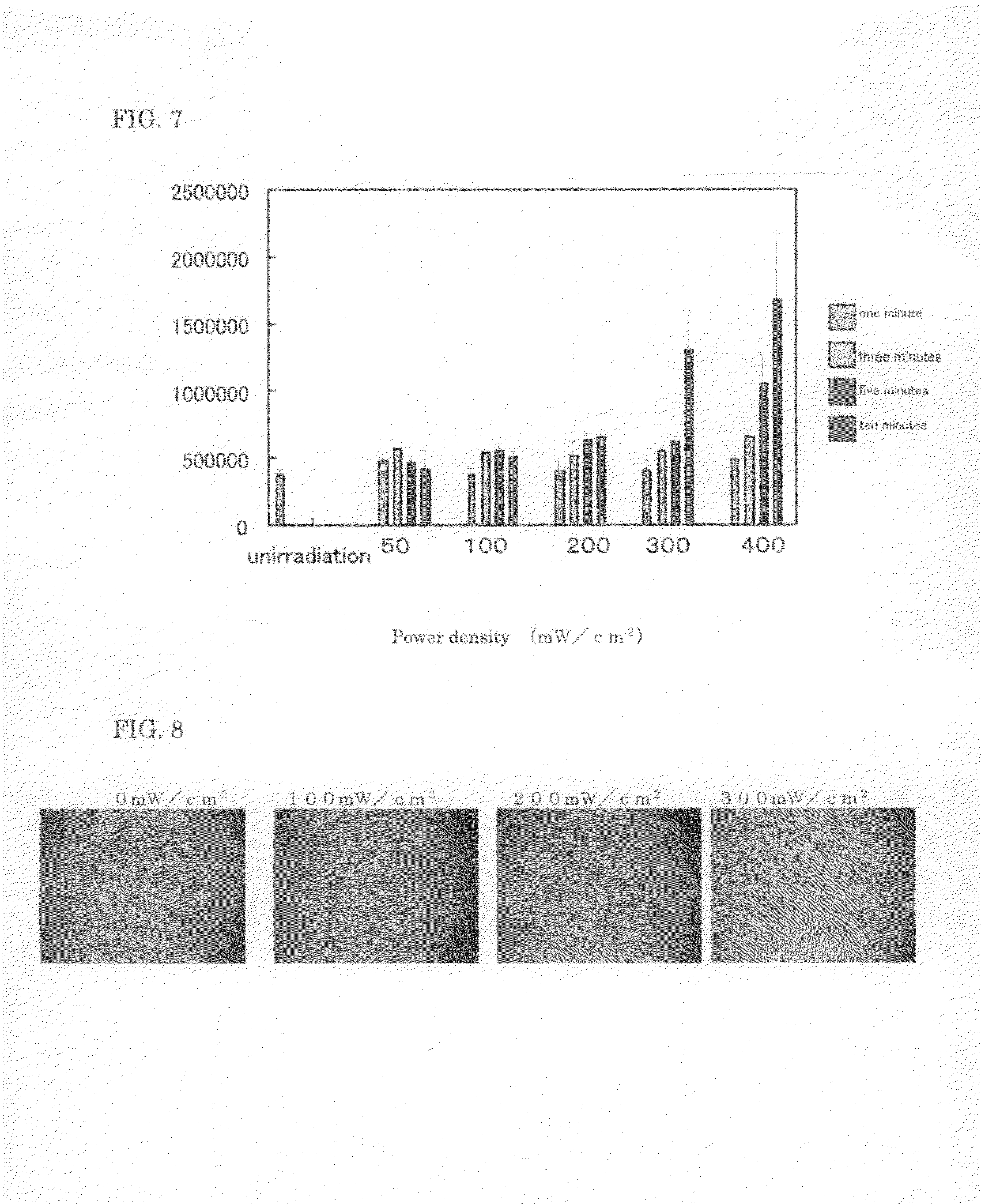Method of differentiation induction to osteoblasts
a mesenchymal stem cell and osteoblast technology, applied in the field of regeneration medicine, can solve the problems of double burden on patients, increased medical expenses, ethical problems, etc., and achieve the effect of broadening the range of medical car
- Summary
- Abstract
- Description
- Claims
- Application Information
AI Technical Summary
Benefits of technology
Problems solved by technology
Method used
Image
Examples
experimental example 1
Differentiation Induction to Osteoblasts
(a) Preparation of Cells
[0072]KUSA-A1 cells, which are one type of mesenchymal stem cells, were cultured in a DMEM medium containing 10% fetal bovine serum (FBS) by using a culturing flask of 75 cm2. Cells at a logarithmic-growth phase were taken out the day before the day for the laser irradiation. The taking out was performed by the following way. First, the KUSA-A1 cells were floated from the bottom face of the culturing flask by using 0.25% trypsin. The number of cells was counted with a hemocytometer. A cell suspension was obtained by adjusting the number of cells to 1×107 cells / mL using a DMEM medium containing 10% FBS. The cell suspension was separately put into a 96-well multiplate (Falcon, made by Japan BD) at 100 μL / well. The cells were cultured one night at 37° C. and in an environment of 5% CO2 using a CO2 incubator.
(b) Laser Irradiation
[0073]The 96-well multiplate into which the KUSA-A1 cells were separately put in the previous da...
experimental example 2
Measurement of Cytotoxic Activity
(a) Laser-Lightwave Irradiation to Cells
[0080]The cytotoxic activity was measured by the following way. First, CHO (pMAM-HSluc) cells were cultured in a culturing flask of 75 cm2. The cultured cells were floated by a 0.25% trypsin treatment. A cell suspension was pre-pared by adjusting the number of cells to 1×107 cells / mL by using a DMEM medium containing 10% FBS. The cell suspension was separately put into a 96-well multiplate (Falcon, made by Japan BD) at 100 μL / well. The cells were cultured one night at 37° C. and in an environment of 5% CO2. Subsequently, a laser-lightwave irradiation was performed at varied power densities of 50, 100, 200, 300, and 400 mW / cm2 by using a GaN-based laser irradiation device (VLM500, made by Sumitomo Electric Ind. Ltd.). The irradiation period was also varied to 1, 3, 5, and 10 minutes. The irradiation was performed to the individual groups of three wells by varying the irradiating condition as described above. As ...
experimental example 3
Suppression of the Manifestation of Cryptochrome
(a) Design of siRNA
[0082]To examine whether or not cryptochrome is a molecule whose switch is turned on by a violet laser lightwave, a test was performed using the siRNA of cryptochrome. For the sequence of the siRNA, two types of siRNA were designed that have sense strands of the SEQ ID NO: 1, which is 5′-GCAGACUGAAUAUUGAAAGTT-3′, and the SEQ ID NO: 2, which is 5′-GGCACUUACACGUUUGGAATT-3′. In the above, the sequence is designed based on the sequence of the mRNA of the cryptochrome. The production of the sense strand and antisense strand of each of the SEQ ID NOS: 1 and 2 and their annealing were outsourced to Ambion Inc.
(b) Transfection of the siRNA
[0083]The preparation of cells and transfection to them were performed by the following way. First, KUSA-A1 cells were cultured in a culturing flask of 75 cm2. The cultured cells were floated by a 0.25% trypsin treatment. A cell suspension was prepared by adjusting the number of cells to 1×...
PUM
| Property | Measurement | Unit |
|---|---|---|
| time | aaaaa | aaaaa |
| time | aaaaa | aaaaa |
| wavelength | aaaaa | aaaaa |
Abstract
Description
Claims
Application Information
 Login to View More
Login to View More - R&D
- Intellectual Property
- Life Sciences
- Materials
- Tech Scout
- Unparalleled Data Quality
- Higher Quality Content
- 60% Fewer Hallucinations
Browse by: Latest US Patents, China's latest patents, Technical Efficacy Thesaurus, Application Domain, Technology Topic, Popular Technical Reports.
© 2025 PatSnap. All rights reserved.Legal|Privacy policy|Modern Slavery Act Transparency Statement|Sitemap|About US| Contact US: help@patsnap.com



